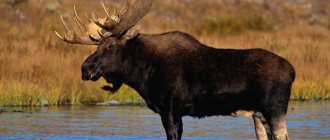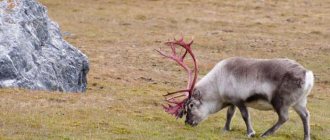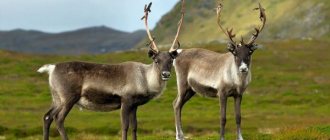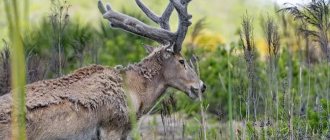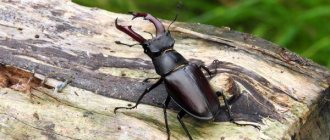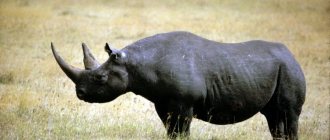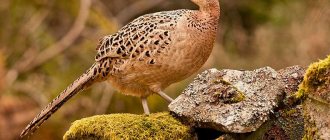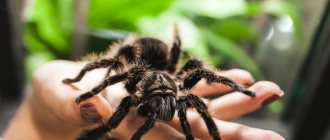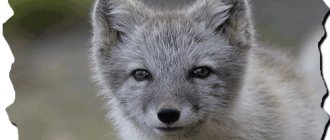Description of reindeer
The height of the reindeer at the withers is about 1.5 m, the body is oblong, its length is about 220 cm. The weight of the animals is from 100 to 220 kg.
Females are always smaller than males. — Advertising —
The color of the fur of reindeer is very diverse, and includes many shades of brown and brown. The inhabitants of forest zones are painted in the darkest tones; specimens that live on islands are usually lighter. In winter, the animal’s fur changes color, it becomes much lighter, and there are individuals of a beautiful ash color. The coloring of male and female reindeer is the same. During molting, the summer coat, which reaches 1 cm in length, is replaced by winter coat, which is very long and thick. The structure of the fur allows this animal to withstand fairly low temperatures and also to swim.
Besides the fur, the structure of the reindeer's hooves is unusual. The hooves are wide, helping to stay on the surface of the snow; between them there are long hairs that perform the same function. The shape of the hooves is concave, making it convenient to dig with them and the animal can get food from under the snow.
Of course, the main pride and dignity of a reindeer are its antlers. Both males and females of this species have them. But the former have more luxurious horns, they are very branched and long. For the winter, males shed their antlers, and females become hornless only after giving birth.
Types of deer suitable for farming
Despite the fact that in Russia and throughout the post-Soviet space the reindeer herder is most often associated with reindeer, all over the world various species from the deer family are kept on farms and they do it quite successfully. Let's talk a little about this.
So, let's start with the basics, in the deer family there are approximately 51 species of animals, they have a diverse lifestyle and habitats, therefore, from the point of view of farming, they can be divided into three groups: suitable for keeping on farms, suitable for keeping in open-air cages and species that They are not kept on farms or in enclosures for various reasons.
Let's consider the first group, those who are kept on farms.
In our country these are reindeer, red deer of various subspecies, sika deer and fallow deer. Recently, enthusiasts who keep white-tailed deer have begun to appear.
Reindeer ( Rangifer tarandus ) Reindeer is the most numerous in Russia, and its distribution area is the most extensive, so it would be logical if we start with it. The reindeer population, according to data for 2022, is 1.7 million heads, although the reliability of this data is questionable for a number of reasons, and this number may be somewhat overestimated.
Adult male reindeer
The popularity of this deer is that it has adapted to live in conditions where no other farm animal can be kept. This deer can be kept not only in the north, but also in much southern regions of Russia, right up to the North Caucasus. True, in this case there will be no industrial use of the deer; its entire purpose is the sphere of entertainment and winter exoticism. Reindeer meat has a specific taste; due to the specific habitat of the deer, it is quite tough. Antlers, compared to other types of deer, have no value. In the north, keep it in hundreds, or even thousands, in central Russia we will be talking about a dozen for winter rides.
Red deer subspecies (maral) (Cervis elaphus sibiricus) Siberian red deer is the second largest species of deer in Russia. At the moment, it is kept on farms of about 220,000 heads. 80% of the livestock is kept in the Altai Republic and 4 districts of the Altai Territory. This is a Siberian deer; it lives in the wild in the south of Siberia. Height at withers 1.5 meters height at withers, body weight 250-300 kg. The horns of the deer have a powerful main trunk, a small number of branches, and at the end the horns bend slightly back. Unlike the European red deer, the Altai deer is gray in color.
Rogach of the Altai maral
Traditionally, the Altai maral is kept for its antlers. The fact is that due to a variety of factors, they are historically valued above others in the Southeast Asian market. It is not possible to keep a large population of deer in Altai for a number of reasons; there are very few flat areas of land on which to prepare food for the winter; grains have to be imported from the neighboring region. Although the pastures are rich in the variety of herbs, they are inferior in the amount of nutrients to the plains. Therefore, deer breeders have to fence off large spaces for livestock and reduce the number of deer per hectare (2 hectares of land per 1 deer), so antlers are the most effective way to “reap” the maximum profit from a deer. Although the Altai deer is suitable not only for these purposes. Considering that it is larger than red deer, it is more interesting as a source of venison. True, due to the climate, deer meat has a slight difference from meat from European deer - its fat has a higher melting point. Perhaps the reason is purely genetic, but it is very likely that this is a way of adapting to the harsh climate.
Red deer subspecies (Cervus elaphus hippelaphus ) Red deer. Red deer - eurytope
[Greek
eurys
- wide and
topos
- place, locality] - an organism capable of existing in a wide variety of environmental conditions, i.e., having a wide ecological valency. Therefore, it can be bred in almost any region of our country, with the exception of a very harsh climate, which is subject only to reindeer. And from cold Karelia to hot Rostov, forests, fields, hilly areas or even mountains - everything is suitable for keeping, and the deer will feel confident everywhere. The sizes of deer also vary: from large Carpathian bloodlines to small island ones of English or Scottish genetics.
Male European red deer of English selection
This is the most common type of deer on European farms; it is what Europeans imagine when they talk about reindeer herders.
The deer fits literally any direction of the deer farm. Red deer venison has traditionally been in great demand and its consumption is growing, especially in Western Europe. From time immemorial, the red deer has been considered a royal trophy. According to the results of laboratory studies, antlers are not much inferior to the antlers of the Altai deer.
Direction of reindeer husbandry in European countries.
Sika deer (Cervus nippon) Sika deer - Farming of sika deer is widely popular in Southeast Asian countries. In Russia, there were also numerous farms in Altai and Primorye, but due to the economic situation, the number sharply decreased. At the moment, the sika deer is popular only as an open-air animal for which quite interesting hunts are carried out.
Male and female sika deer in split before processing
Deer also has a variety of practical uses: venison is considered tastier than that of red deer. The spotted antlers are more expensive than the noble one, but are much smaller in size. Hunting for spotted fish is popular both in terms of prey quality and availability. Keeping on farms is possible, subject to long-term taming of captive and wild individuals.
Sika deer farm in China
Fallow deer (Lama lama) - Considering that land is very scarce in Europe, the average farm size is 4-5 hectares depending on the country. If you keep a red deer on such a piece of land, this small herd will be unprofitable, so it is not surprising that European reindeer herders prefer fallow deer; its density can reach 15 animals per hectare.
According to statistics from the European Reindeer Herders Association FEDFA for 2010, there were 75,150 owners of red deer and 204,550 owners of fallow deer.
Male fallow deer on the farm
Deer also has wide farming uses: venison, hunting, some parts are used in traditional Chinese medicine. In Russia, the fallow deer has not yet received widespread farming use; here it has competitors in the form of sika deer, but the deer has its own charm.
Livestock of red deer and fallow deer on European farms
White-tailed American deer (Odocoileus virginianus) White taled deer - belongs to the same subfamily as the roe deer; in principle, they are similar in some behavioral traits. According to some data, as of 2022, there were 600 white-tailed deer in Russia. Its height at the withers is 1.1 meters, body weight reaches up to 130 kg. The deer is American, so it is highly advertised by the American marketing machine. It has characteristic horns that cannot be confused with anything - the pointed ends immediately point forward.
Male white-tailed deer on a farm
White-tailed deer are the rarest visitor to our farms. In 2014, when expanding the classifier of farm animals, deer bred in Russia were added to the list, but white-tailed deer were not there.
In America and Canada, this deer is very popular as a farm animal. This deer has the highest fertility of any other species I have described, up to 170 calves from 100 females, while twins are common, and triplets are not uncommon. America's wild population is difficult to count, but hunters harvest 10.9 million white-tailed deer each year. The U.S. hunting industry generates $33.7 billion in revenue and includes white-tailed deer farms. Deer farming industry reaches $4 billion, American farmers have achieved good results in deer genetics.
60% of Canadian and American farmers' income comes from selling meat, but they are also trying to carve out a place in the Chinese medicine market by selling antlers and dried animal blood. Trophy hunts for good specimens are also organized. Breeders note the most delicate taste of the meat, although when I asked American hunters about this issue, they did not express much delight - apparently, there were no comrades for the taste and color here either.
Well, now a little about the problems of this type. The deer is quite small compared to other types of farm deer, and because of this it is very nervous and aggressive. During the rut, white-tailed deer engage in wild fights to the point of death, and can also injure females. Breeders note that adult males are absolute owners, they do not form herds, and drive out rivals to the last, so it is necessary to keep them in small separate enclosures.
You have to work with deer in complete darkness in order to somehow reduce the animal’s stress. Further cases of focal infection in internal organs were noted. Laboratory studies have not yet identified the reason, whether due to climate change or nerves, deer suppress their immune system, and they develop something like an autoimmune disease. So far there is little data on the maintenance of this deer, so we will have to wait to find out the etiology of the diseases.
Well, the main reason for the unpopularity of white-tailed deer on our farms is its price. The first copies were sold at a completely indecent price - due to air transportation. Now the price tag has dropped a little, but is still at the level of a good breeding red deer imported from the UK.
Unfortunately, the breeders still have little experience, the livestock is small, but thanks to good fertility and adaptability, this deer has good prospects in the northern regions bordering the reindeer breeding range.
Now to the world experience of reindeer husbandry.
Axis - The homeland of this deer is India Nepal Sri Lanka. The most common species of deer in its range. Axis were known to the Romans and were later introduced into the parks and hunting grounds of Western Europe; they easily acclimatized where there are no severe frosts and long-term high snow cover. There are herds of Axis in Europe that have lived for more than 150 years. In the 1860s it was brought to Australia, and in 1867 to New Zealand, but the population grew quickly and became a threat, so the settlers changed their minds, but Texas, Brazil, and Argentina became the new homeland for the deer and became the subject of hunting there. Externally similar to sika deer, but smaller in size and slightly different
Axis on a farm in India
Barasinga is an Indian word for deer meaning “deer with twelve antlers,” which in this case are understood as shoots. In fact, the horns of a barasing can have from 10 to 14, and sometimes up to 20 branches. Barasinga is a large deer with a height at the withers of 110 to 120 cm and a body length of almost 180 cm. Deer weigh 170 to 280 kg. Females are less heavy, weighing about 130 to 145 kg. Large males weighed from 210 to 260 kg. Barasinghi breed quickly. Like many deer living in tropical climates, they do not have a clear breeding season and they can give birth to calves throughout the year, but mostly offspring appear after the rainy season in October-November, since at this time there is a large amount of lush greenery of their main stern. They are more widespread as an object of open-air hunting; they are rarely kept on farms.
White-faced deer - It is also called the Tibetan red deer, and in the English version it is for some reason called Thorold's deer. Which is completely unfair, because the deer is very little studied, but its first description was given by the Russian traveler Przhevalsky in 1883. In our taxonomy, this deer is called Przewalskium albirostris in Latin. The deer is quite large, height 130 cm, length up to 200 cm, weight up to 200 kg, which is comparable to the European red deer. the horns are also white and have up to 5 branches. What distinguishes it from the rest is its wide hooves, thanks to which this deer climbs well and climbs mountains up to 5000 m, apparently so as not to disturb the others. Prefers bushes, but feeds on grass. Behavior is similar to the European, boys graze separately from girls, boys are horned, girls are not, children are spotted. It got its name because of its white nose and lips, it looks as if this curious animal had its nose in the flour. Since the deer lives in Tibet, that is, in China, naturally they found a bunch of miraculously effective body parts and the deer was almost exterminated. At the moment, deer live in zoos and about 100,000 live in rugged mountainous areas. The object of the Red Book therefore any economic activity with this animal is prohibited.
Swamp deer - Marsh deer if someone is looking for information in English. The largest deer in South America, body weight up to 150 kg, height up to 120 cm, body length 180-200 cm, which is approximately comparable to the English red deer. The deer really spends a lot of time in the swamp, where it has succulent food and protection from predators. It has wide hooves between which an elastic membrane passes. Males are not very aggressive towards each other, and they don’t really fight for the female, which is probably why the species is under threat. Deer lead a hidden lifestyle, graze in swamps, and feed at dusk. Natural enemies: jaguar, puma, anaconda and stray dogs. Although the main threat to this deer comes from hunters. The object of the Red Book therefore any economic activity with this animal is prohibited.
Wapiti is the largest deer; only elk is larger than it in the deer family. According to our Russian classification, wapiti belongs to the red deer, but English-speaking countries distinguish it into a separate species, Cervus Canadensis, which includes our maral; their voices are extremely similar and very different from the European deer. On New Zealand farms, this deer is kept for hybridization with the European red deer, to obtain larger antlers, antlers, and venison.
Male wapiti in New Zealand
Water deer - Lives well in parks in France and England. They sometimes hunt him there
Sambar - or as it is called in English-speaking countries, Sambar deer. Sambar has several subspecies, the largest is Indian, the smallest is Philippine, there are also maned and other endemics of the islands. The Indian sambar is the largest deer in India. Despite its size, the deer moves through the forest almost silently, which arouses the interest of hunters in such prey. Because of this, in its native range, sambar is listed in the Red Book, but in 1907 it was brought to Australia and New Zealand, where, in the absence of predators, the deer reproduced well, so that it is hunted year-round.
Musk deer or musk deer - Since the musk deer is a solitary animal, for mating males attract females with the help of an odorous gland - musk, for the sake of this gland, musk deer have been hunted all this time. A musk deer stream costs up to $50 per gram, and in a year a male can accumulate a maximum of 20 grams of musk. This is the most expensive substance obtained from an animal in nature. Breeding experience has been going on since 1976; about 200 calves have been received in captivity. In 2022 there was a conference in the Altai Mountains, we decided to remember the experience and start breeding musk deer more industrially.
Roe deer is also a goat, the Latin name of the genus Capreolus, in English it is called roe deer, after all, a deer. This is a small interesting animal. There are two subspecies living in Russia, the Siberian and the European; there are only 4 in the world. Body weight ranges from 23 kg for the European to 60 for the Siberian. Body length 100-150 cm, height 80-100 cm. Roe deer can be bred on farms and in parks, I know there are such farms in the Czech Republic, but this is a very nervous animal and it is very difficult to tame it.
Mazama - The name "mazama" in the language of the South American Indians simply means deer. The largest of the mazamas, Mazama Americana, is 67-80 cm high, 105-144 cm long, individual males weigh up to 65 kg, most often 48. Mazamas are hidden animals, they live in the jungle, alone, so there is little information about them. They have adapted well to living among people and often find refuge on coffee plantations. They quickly get used to people and become tame; in captivity they live up to 7-9 years.
Muntjac is a genus of small deer that includes 12 species, 5 of which were discovered after 1990. They are also called barking deer because of the sounds the deer make. The deer is the size of a bull terrier and has simple antlers that only grow on males. This saber-toothed deer has fangs in both females and males; by the way, in fights, the deer relies more on its fangs than on its antlers. The deer lives in southeast Asia, and before the last glacier it lived in Europe. It feeds on grass, leaves, fallen fruits, mushrooms, carrion, bird eggs and small animals, which it kills with its hooves and fangs. The deer is a loner, but loves to talk, so you can listen to its barking for a long time in the jungle. Farmers don't like these deer because they spoil crops, but their meat is considered a delicacy. It is perfectly domesticated and lives on farms and in open-air parks, such as at the Woburn farm in Southern England; in captivity it lives up to 16 years, but usually 10.
Muntjac in Woburn Park
Mouse deer aka Pudu Pudu deer - The smallest of the deer, length up to 80 cm, weight 7-13 kg. There are two types: Northern Pudu and Southern Pudu, Northern Pudu is slightly larger. They live in the jungles of South America. Chile, Argentina, Ecuador, Peru, Colombia. Due to its small size, it has a lot of enemies, therefore it is very secretive; most of the information about the deer was obtained due to keeping it as pets
David's deer is the largest of the Chinese deer. The deer has a rather tragic fate. Due to uncontrolled hunting and deforestation, deer were almost exterminated in China, then the emperor put the remaining ones in a closed park, where hunting was prohibited under penalty of death, and foreigners were generally forbidden to look at it. But nevertheless, the French abbot Armand David persuaded to give these deer to France and England. Things didn’t work out in the French zoo, but in England they were placed in Woburn Park where the deer were kept for more than 120 years. There they were used as lawnmowers, hunted, and in general the deer were in business. In China, at the same time, there was a flood and some of the deer died, and some fled, but the rest were killed during the Boxer Rebellion. It so happens that the largest herd of Chinese deer grazes in southern England.
Lyre deer - Named because of its unusually shaped antlers. The lyre deer belongs to the group of “true deer”. The dimensions are approximately similar to the sika deer: height at the withers 114 cm, length 180, weight 80-140 kg. The horns are really beautiful. There are very few deer in nature; they are generally an endangered species; some of its subspecies have already been erased from the biological diversity of our planet. The last time great damage was done to the surviving deer was during the Second World War and in the early post-war years. In 1951, the Manipur Forest Department reported the complete disappearance of the deer. However, this was not confirmed.
Male lyre deer at the zoo
The pampas deer is a small, graceful deer of South America. Body length is 130 cm, height at the withers is 75 cm, weight is up to 35 kg, but these are data for wild deer; those that live in captivity have smaller sizes. Commercial trade in these animals is prohibited. Poaching is strictly controlled in Argentina. A big plus is that the pampas deer reproduces well in captivity.
The Indian Hog Deer (Axis porcinus) is an artiodactyl mammal native to South and Southeast Asia. It got its name from its manner of movement. Belongs to an endangered species. Hog deer have become rare in many parts of their range due to the development of swamps and their use as rice fields. Nevertheless, hunting for pig deer is widespread in the USA and Australia, where they are kept in parks or enclosures.
Hangul - Its other name is Kashmir deer kashmir stag or Bukhara deer. lives in India in the extreme southeast of the Pamirs. Large males weigh up to 180 kg, the average length of their horns is 100 cm (the record is 128.3 cm). For a long time it was considered a subspecies of the red deer and its Latin name was Cervus elaphus hangul, but a mitochondrial study by Canadian geneticists found that this deer is much closer to the wapiti than to the red deer and in some sources it is already called Cervus canadensis hangul, both names pop up in searches, but so that it doesn’t get boring, there is also a group of researchers who distinguish Hangul into a separate species, Cervus affinis, with two subspecies: Yarkand deer and Bukhara deer. The deer lives right at the junction of the western and eastern range of deer. It is listed in the Red Book due to constant armed conflicts in the region where the deer lives. In Kazakhstan and Turkmenistan, work is being done to restore the number of this deer in enclosures.
A group of hangul males in an enclosure.
Tufted deer is small in size, a relative of the muntjac, length 110-160, height at the shoulders 50-70 cm, the little one weighs up to 50 kg. It has horns that are invisible in its hair, as well as motionless protruding fangs. They are solitary, communicate by barking, in general everything is like a muntjac, the deer is small and therefore has a good camouflage coloring, which makes it invisible in the forest. Lives in China, the range reaches Burma, often climbs high into the mountains up to 4500 meters. Despite the fact that it can settle near a person, it leads a hidden lifestyle and is not so easy to see.
Dietary features of reindeer
Reindeer is a herbivore. He is able to feed on almost all the plants that only he can find in the harsh conditions of his habitat. The basis of the animal’s diet is moss, a lichen that grows in the northern regions. Since reindeer moss contains insufficient amounts of vitamins, reindeer also eat berries, mushrooms, various herbs, and even cereals, everything that it finds in the summer. Reindeer especially love cereal plants. For example, domesticated reindeer are mainly fed silage and hay.
Lifestyle and nutrition
Deer lead a nomadic herd lifestyle, migrating annually. The length of one passage can reach 500 kilometers. Over the years, deer migrate along the same route . If it is necessary to overcome water obstacles, deer easily swim across rivers. This way of life allows the nutrient layer of the earth to be completely restored.
During migration, reindeer are subject to frequent attacks from predators:
- wolverines,
- wolves,
- bears,
- lynxes
Attacks occur on old and sick group members. Most often, deer are attacked by wolves and wolverines. But lynxes and bears approach the herd only in case of an acute shortage of other game . Frightened reindeer gallop to escape. The animals are no different in activity. They lead a predominantly diurnal lifestyle.
Animals eat not only plant foods:
- all types of lichen,
- mushrooms,
- other people's eggs,
- algae.
If necessary, deer can even eat adult birds. They love to lick salt, which is a source of potassium and magnesium. Thanks to their powerful legs, deer find food even under the snow. For the same purposes, deer drink large quantities of salty sea water , although they eat regular snow to quench their thirst. When the balance of minerals in an animal's body is disturbed, they can even gnaw on each other's horns.
Distribution of reindeer
— Advertising —
According to their habitats, reindeer are classified into tundra, forest and mountain reindeer. These names correspond to where this or that population lives. Tundra deer live in the tundra, forest deer prefer forests to live, and mountain deer are found in the mountains. This division is rather arbitrary, since this species is prone to frequent migrations and constantly changes its places of residence.
The reindeer's habitat includes North America, Russia, Kamchatka, northern Canada, Alaska, Sakhalin and Taimyr. This is why this species of deer received the name northern, since it primarily lives in the harsh northern climate.
Common subspecies of sika deer
There are about 15 subspecies of sika deer, which differ in size and habitat.
For example, wapiti and marals are very large deer, their body length sometimes reaches 2.5 meters, weight up to 300 kg, and Bukhara deer, on the contrary, are relatively small in size, their weight is up to 100 kg, and their body length ranges from 75 up to 90 cm. The shape of the horns also differs among the subspecies of sika deer. Thus, European deer have many branches, and deer have a massive branched horn without a crown.
Reindeer behavior
In summer, reindeer live on the Arctic coasts.
During this period, in any other areas they are attacked by clouds of midges, and only cool arctic winds prevent the midges from bothering the animal. After the onset of cold weather, reindeer form herds and move into the forests. When migrating, animals look for areas where there is not a lot of snow, since from under large snowdrifts they simply will not be able to get their food. Migrations stretch over 500 km, while deer swim across rivers and overcome other obstacles in search of places suitable for their life. When May arrives, the herds head back to the tundra. It is interesting that the movements of groups of reindeer always take the same road.
Reindeer usually live in herds. Sometimes single individuals are found, but in general this is very rare for this species. The number of animals in a group is variable. Usually there is one male, and females with young animals.
A dominant male protects his herd, both from other males and from predators. He marks the territory of his group with a special secret and drives away all strangers and strangers from it.
Sika deer behavior
Wild spotted deer are secretive, shy, quiet and very cautious animals.
It is very difficult to meet representatives of this species in forests, since they can sense the approach of people and predators at long distances. The sika deer is helped in this by its well-developed hearing and sense of smell. In general, sika deer are not easy prey. He can run fast when being chased and swims well, so he can easily hide from predators pursuing him in the water. In such cases, the animal jumps into the water and quickly swims to the depths. On water, sika deer are capable of covering distances of several kilometers. In addition, this animal is capable of jumping 2.5 meters in height and up to 8 meters in length.
Sika deer lead a sedentary lifestyle in small groups, sometimes uniting in large herds. The home range of one herd is several square kilometers, which the deer mark and whose borders are protected from all strangers. Grazing occurs mainly at night, when the risk of attack by predators is not so great.
Reindeer breeding
The mating season for reindeer begins in mid-October and lasts until the end of November.
At this time, males behave especially aggressively and often engage in real fights with each other. The strongest male wins the right to mate with 10 or more females during the rutting period. Pregnancy lasts about 8 months, the offspring are born in late spring or early summer. Typically, a female reindeer has one baby per litter. Twins are born very rarely.
A newborn fawn is very small and weak, its weight barely reaches 6 kg, but a few days after birth it already begins to develop horns. In general, the fawn grows and gains weight quite quickly, since soon after its birth the migration period begins, which involves covering quite significant distances. Adult males closely monitor their herds, protect them from predators, and in case of attacks they even engage in battles with the latter in order to protect their females and offspring
A newborn fawn stays with its mother for the first two years of life, until puberty. The lifespan of a reindeer is about 25 years.
Natural enemies of reindeer
Reindeer are most vulnerable during their migrations, when even adult individuals are attacked by predators such as wolves, wolverines, lynxes and others. But the greatest harm to the population of this animal is caused by people, namely, uncontrolled hunting and poaching for the purpose of obtaining antlers (young horns).
Natural enemies of sika deer
Sika deer have a lot of natural enemies. Among the predators that attack them are wolf, leopard, tiger and bear. Young animals often become victims of Ussuri yellow martens (harza) and lynxes. In winter, when there is a lot of snow and in spring, sika deer become very weak due to poor nutrition and often become prey to predators.
Interesting facts about reindeer
- Antlers or unossified deer antlers have medicinal properties and are widely used in both folk and official medicine. An extract is isolated from them, which has general tonic and adaptogenic properties. Professor I. I. Brekhman in the middle of the last century developed a medicinal preparation from reindeer antlers, tablets called “Rantarine”, and a liquid product “Velcornin”. The drug "Epsorin" was the first high-quality extract obtained from the antlers of wild reindeer. The ossified horns of this animal species are used to make the food supplement “Tsigapan”, which is endowed with immunostimulating properties.
